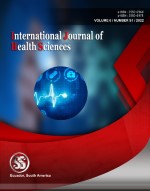Comparative safe-reduction of body weight in rats by using different doses of formalin
Keywords:
blood urea, formalin, obesity, safe-reduction, serum creatinineAbstract
Body weight gain and obesity have a significant influence on quality of life since they are related with comorbidities and psychological issues. The latter is far more significant than most people think. Formoline L112, a formulation containing polyglucosamine, a chitosan derivative, is one of the most often used products in Europe to help people lose weight. Aim of the study: to evaluate dose-related body weight reduction in rats with possible measuring of drug's safety. Materials and method: 30 rat were classified into 3 groups; group 1 (No.=10) used as control, group 2 (No.=10) given 1 tablet of formoline, and group 3 (No.=10) was given 2 tablet each 12 hours\day. The body weight of each rat was taken before and 30 days after treatment. Blood urea and serum creatinine was assessed before and after using the drug to exclude renal injury. Results: there was significant reduction (at P<0.05) in body weight by using either single or double doses of formoline as compared to control group with no statistical significance of using single dose as compared to double dose.
Downloads
References
Barrea, L., et al. (2019). "Nutritionist and obesity: brief overview on efficacy, safety, and drug interactions of the main weight-loss dietary supplements." International Journal of Obesity Supplements 9(1): 32-49.
Blüher, M. (2020). "Metabolically healthy obesity." Endocrine reviews 41(3): bnaa004.
Caussy, C., et al. (2020). "Prevalence of obesity among adult inpatients with COVID-19 in France." The Lancet Diabetes & Endocrinology 8(7): 562-564.
Chiu, C.-Y., et al. (2020). "Comparative effects and mechanisms of chitosan and its derivatives on hypercholesterolemia in high-fat diet-fed rats." International journal of molecular sciences 21(1): 92.
Cnubben, N. H., et al. (2016). "A single oral dose of a polyglucosamine influences the bioavailability of [9-14C]-Oleic acid in adult female Göttingen minipigs." BMC obesity 3(1): 1-12.
Geserick, M., et al. (2018). "Acceleration of BMI in early childhood and risk of sustained obesity." New England Journal of Medicine.
He, N., et al. (2020). "Low molecular weight chitosan oligosaccharides (LMW-COSs) prevent obesity-related metabolic abnormalities in association with the modification of gut microbiota in high-fat diet (HFD)-fed mice." Food & Function 11(11): 9947-9959.
Heslehurst, N., et al. (2019). "The association between maternal body mass index and child obesity: A systematic review and meta-analysis." PLoS medicine 16(6): e1002817.
Jo, S.-H., et al. (2013). "Molecular weight dependent glucose lowering effect of low molecular weight chitosan oligosaccharide (GO2KA1) on postprandial blood glucose level in SD rats model." International journal of molecular sciences 14(7): 14214-14224.
Liu, S.-H., et al. (2020). "Effects of chitosan oligosaccharide on plasma and hepatic lipid metabolism and liver histomorphology in normal Sprague-Dawley rats." Marine Drugs 18(8): 408.
Lütjohann, D., et al. (2018). "Influence of chitosan treatment on surrogate serum markers of cholesterol metabolism in obese subjects." Nutrients 10(1): 72.
Naveed, M., et al. (2019). "Chitosan oligosaccharide (COS): An overview." International journal of biological macromolecules 129: 827-843.
Otto, C., et al. (2008). "Significant Weight Loss under formoline L112 in Overweight Patients with Type 2 Diabetes." formoline-Concept: 73-92.
Perna, S., et al. (2020). "Effect of Polyglucosamine on Weight Loss and Metabolic Parameters in Overweight and Obesity: A Systematic Review and Meta-Analysis." Nutrients 12(8): 2365.
Polyzos, S. A. and A. N. Margioris (2018). "Sarcopenic obesity." Hormones 17(3): 321-331.
Russo, L. and C. N. Lumeng (2018). "Properties and functions of adipose tissue macrophages in obesity." Immunology 155(4): 407-417.
Saleh, H. and H. M. El-Shorbagy (2020). "Chitosan protects liver against ischemia-reperfusion injury via regulating Bcl-2/Bax, TNF-? and TGF-? expression." International journal of biological macromolecules 164: 1565-1574.
Sanhueza, L., et al. (2018). "Formoline L112® asociado a terapia no farmacológica en el manejo de la obesidad en diabéticos y prediabéticos." Endocrinología y Diabetes 11(3): 91-96.
Schönbach, K. (2019). Persuasionsstrategien. Verkaufen, Flirten, Führen, Springer: 69-96.
Stoll, M., et al. "Randomisierte, doppelblinde klinische Studie zum Vergleich von Orlistat 60 Milligramm und einem kundenspezifischen Polyglucosamin, zwei Behandlungsmethoden für das Management von Übergewicht und Adipositas."
Wang, Y., et al. (2020). "Has the prevalence of overweight, obesity and central obesity levelled off in the United States? Trends, patterns, disparities, and future projections for the obesity epidemic." International journal of epidemiology 49(3): 810-823.
Weihrauch-Blüher, S. and S. Wiegand (2018). "Risk factors and implications of childhood obesity." Current obesity reports 7(4): 254-259.
Published
How to Cite
Issue
Section
Copyright (c) 2022 International journal of health sciences

This work is licensed under a Creative Commons Attribution-NonCommercial-NoDerivatives 4.0 International License.
Articles published in the International Journal of Health Sciences (IJHS) are available under Creative Commons Attribution Non-Commercial No Derivatives Licence (CC BY-NC-ND 4.0). Authors retain copyright in their work and grant IJHS right of first publication under CC BY-NC-ND 4.0. Users have the right to read, download, copy, distribute, print, search, or link to the full texts of articles in this journal, and to use them for any other lawful purpose.
Articles published in IJHS can be copied, communicated and shared in their published form for non-commercial purposes provided full attribution is given to the author and the journal. Authors are able to enter into separate, additional contractual arrangements for the non-exclusive distribution of the journal's published version of the work (e.g., post it to an institutional repository or publish it in a book), with an acknowledgment of its initial publication in this journal.
This copyright notice applies to articles published in IJHS volumes 4 onwards. Please read about the copyright notices for previous volumes under Journal History.
















